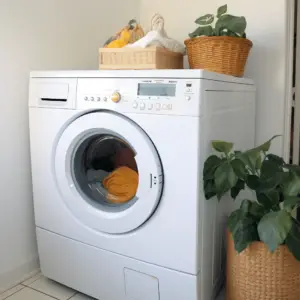Leaking Dryer Causes and Fixes using a clothes dryer and it’s leaking water, there could be a number of causes. The good news is that most of them are easy to fix.
Your dryer may leak because the vent connection is not properly sealed or something’s blocking the dryer’s exhaust hose, which leads outside. In some newer models, condensation may collect inside the dryer and then drip onto the floor.
Water in your dryer is an indication that something is wrong with the machine and needs to be fixed. Leaking Dryer Causes and Fixes, it can cause several problems, including mold, mildew, and water damage in your home.
You might also notice that your clothes come out damp or that you have to run the dryer longer than usual. If you notice water in your dryer, stop using it until the problem is fixed, as continued use could cause more damage.
Read on to learn more about what causes your dryer to leak and how you can fix it.
Table of Contents
Reasons Your Dryer Is Leaking Water

There are many reasons your dryer might be leaking water. Here are a few of the most common:
The Dryer Vent is Blocked
Dryers usually release hot air from the drum. This hot air must be allowed to escape, or it will cause the dryer to overheat. The hot air contains lots of water vapor and small particles of lint. When excess lint is not removed from a dryer’s exhaust system, it can form a sticky residue in the ducting.
When this blockage gets bigger, the dryer will no longer be able to expel all of the water that is inside it, and some of this water will come back out from under where you have attached your exhaust hose.
Cleaning your dryer’s exhaust vent is a simple solution to this problem. A brush should be used to remove as much lint and debris from the vent as possible. Do this at least once a year to ensure that your dryer is working at its best.
Vents Not Installed Correctly
To ensure that the air within an exhaust system is dispersed effectively, ducting should be as straight and horizontally positioned as possible.
If your dryer has multiple exhaust vents or one with too many bends and corners, the air will not be able to flow through it as effectively. This can cause your dryer to work harder and longer than it should in order to get rid of all of the moisture in your clothes.
Leaking Dryer Causes and Fixes also important that your dryer vent is not installed too close to any heat sources. This includes other appliances, the furnace, and even windows. If possible, keep your dryer vent at least 18 inches away from these types of areas.
Also, note that the ducting material used for a dryer’s vent can affect how well the air flows through it, as some materials are more effective at conveying moisture than others.
Plastic and ribbed ducting should be replaced, and metal, non-ribbed ducting installed.
Holes in The Ventilation Duct
Cracks in the ventilation duct will also cause a dryer to vent poorly. You can check for cracks by looking at the outside of your dryer and noticing if there are any gaps or holes in the venting material.
If you find any holes in your ventilation duct, they should be patched or immediately replaced with the defective duct. The same goes for any areas where the ducting has been damaged or crushed.
If the damage is minor and can be fixed without replacing ducts, heavy-duty cooling/heating tape may suffice.
Vent Flap is Defective
The vent flap prevents outside elements from entering your dryer and its vent. If this flap is damaged or not functioning properly, it can cause water from outside to seep into your dryer. The vent flap can be damaged by an accident, insects, or rodents, which may chew on it or get inside of the ductwork and damage it from the inside out. If you notice any holes in your vent flap, replace it immediately.
Condenser Dryer Issues
Condenser dryers are an excellent alternative if you cannot duct a conventional model outside. Instead of venting out the moist air, it is released into a tank from which it can be pumped and used for other purposes later on. If your condenser-type dryer is leaking water, check to see whether that may be due to problems with its internal parts.
Before removing the condenser pump, disconnect your dryer from its power source. Check that the tank is empty and isn’t leaking; next, check for damage to hoses or pumps. Ifs there is evidence of damage to the pump or hoses, replace both. If there is no damage, check for any obstructions in the vent hose.
It find a leak, remove the condensate pump and clean all its hoses with a bottle brush. If there are none, reconnect your dryer to its power source and cycle it through a complete drying cycle. But, if the leak persists, call a professional for assistance.
Vent Duct Insulation Problems

The vent duct insulation is what keeps heat in your dryer and cold air out. If the ductwork is not insulated properly, it can cause problems such as excessive drying time and higher energy bills in colder climates.
If you notice your dryer takes longer than normal to dry clothes or your clothes come out damp at the end of a cycle, it is likely that you have a vent duct insulation problem. A leaking dryer sometimes results from condensation or the formation of ice due to inadequate insulation around the exhaust duct.
To fix this, you need to insulate the ductwork properly.
Final Thoughts
It’s important to insulate your dryer vent properly. If it’s not insulated well, you could be wasting time, energy, and money drying clothes! Also, ensure that the dryer vent is not blocked with lint, other debris, or items that block the flow of air. If you need to clean your dryer vent, use a bottle brush to do so. Replace ducts with cracks and holes with new ones.
If the problem persists, consult a professional to determine the cause and make the necessary repairs.
